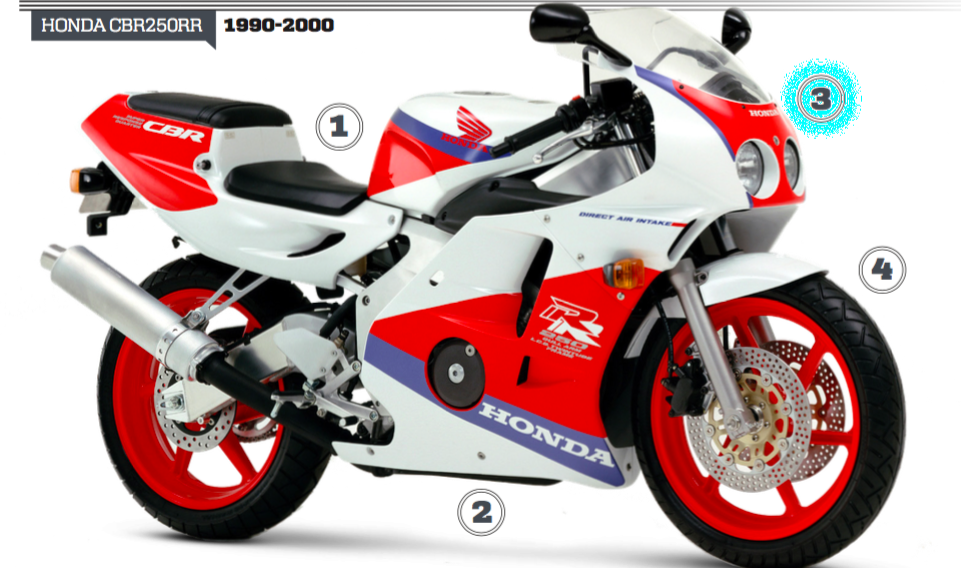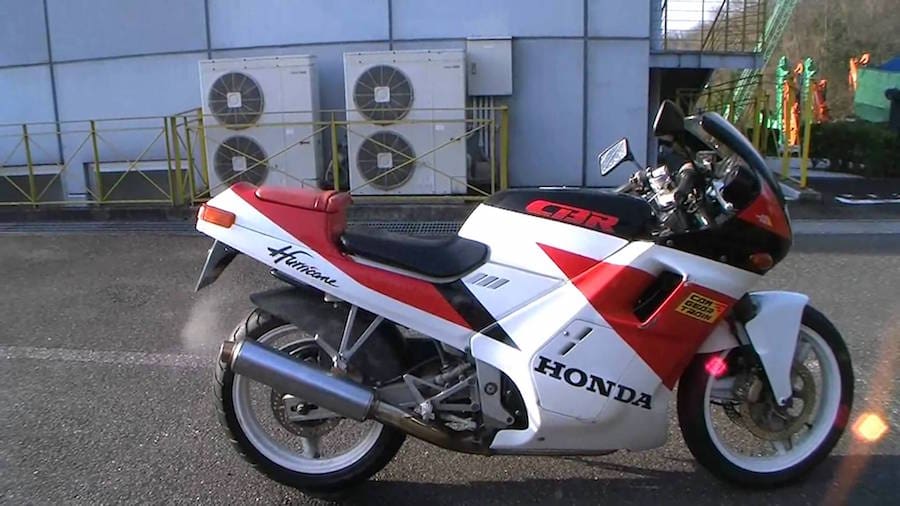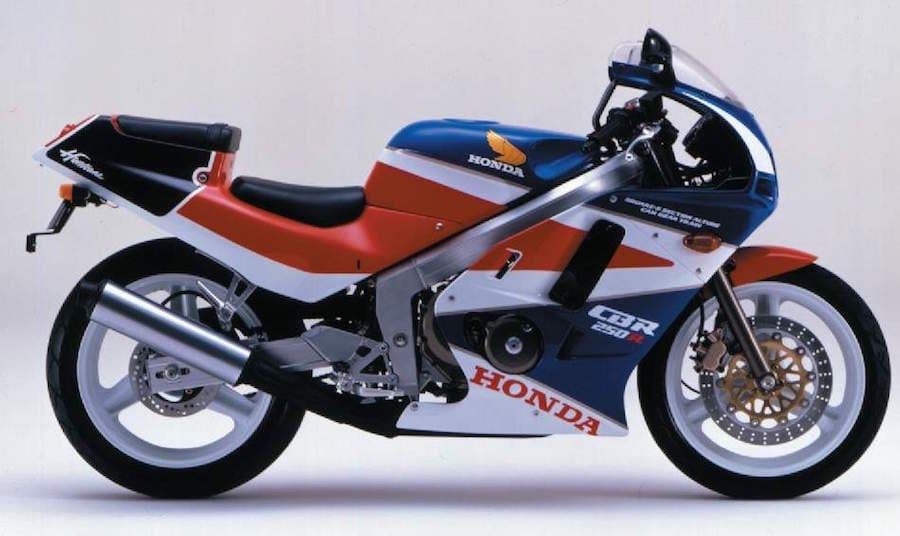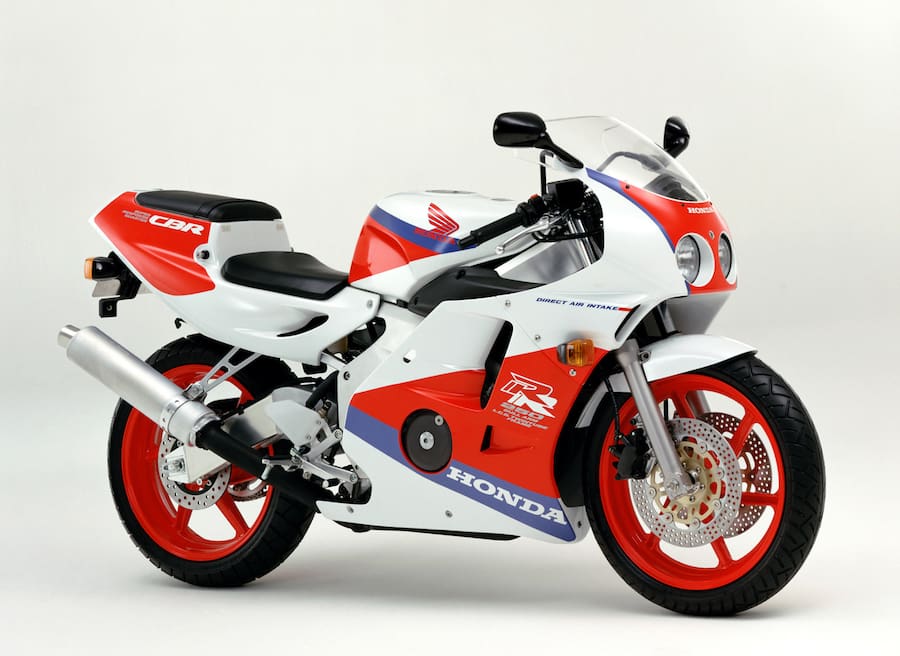Can a 250cc sportsbike really get up and boogie? Try one and be surprised
During the 1960s Soichiro Honda revealed his fondness for multi-cylinder, ultra-high-revving racebike engines. His four-, five- and even six-cylinder bikes, from 125cc to 350cc, were winners in the hands of riders such as Mike Hailwood. The CBR250 RR MC22 ‘Babyblade’ from the 1990s is a roadgoing tribute to Honda’s multi-cylinder race heritage.
The fully faired quarter-litre sportsbike is a potent 158kg (dry) package that showcases sophisticated chassis and powertrain engineering. The twin-spar alloy frame with a 1345mm wheelbase is complemented by a gullwing swingarm with Pro-link pre-load adjustable monoshock and effective, if non-adjustable, conventional 37mm forks. Braking is by twin floating discs up front with powerful twin-pot calipers, and a single rear disc.
The little liquid-cooled ‘Swiss watch’ MC14-type engine packs four cylinders across the frame, with four-valves per cylinder, gear-driven twin cams and carburettor fuelling. A six-speed gearbox hooks up to a chain final-drive.
The pleasingly aggressive-looking fairing mirrors the styling of its big brother, the CBR900RR Fireblade. Many MC22 examples take the illusion (or the respectful gesture) further by copying Fireblade graphics and colours, avoiding a ‘250’ graphic altogether, and including a ‘Fireblade’ label.
The ergonomics of this compact bike are surprisingly accommodating of taller riders; there’s a nice reach to the ’bars and the crouch isn’t as severe as you get on some sportsbikes.
Padding on the 735mm-high seat is sportsbike-thin, not uncomfortable but not up for serious touring. But that’s not what this bike is about.
Nor is it about carrying a passenger much further than the nearest café on that high passenger perch with matching high pegs. At least there’s room under the high pillion seat to stow wet-weather gear.
Underway, the MC22’s lightness and smooth responsiveness to all control inputs makes it easy to ride. The steering lock is a bit restrictive for walking-pace U-turns and manoeuvres, but you soon adjust to that.
If the suspension is in good nick it handles varying road conditions well, providing a sportsbike-firm, well-damped ride.
It’s ridiculous really that I’ve got this far without elaborating on the glorious little 30kW (40hp) four’s performance. Unlike a high-performance two-stroke (Suzuki’s stunning RGV250 for example), the four-stroke Honda can toddle along quite happily at low revs, amazingly pulling away smoothly if unenthusiastically from say 3000rpm, even in top gear.
But why would you? Keep it on the boil and you get what you came for – the pleasure of hearing and feeling the sophisticated motor firing shots in anger.
At around 7000-8000rpm you get a hint, then at about 13,000rpm it starts howling like a racebike, launching toward the 18,000rpm redline with an exhilarating rush. Think about that for a moment – a reliable, rider-friendly, everyday bike that revs close to 20,000rpm. Hallelujah! Thank you, Honda-san.
Picture this: You’re going for broke, stable enough at speed, the little Honda washes off momentum easily and turns in a treat, then apexes the bend faithfully. Now you’re powering out, still heeled over, changing up at around 17,000rpm and picking up the drive in the meat of the 13,000-14,000rpm range thanks to the close-ratio box. How good’s that?
Apart from their ability to tingle your spine, these little Hondas are versatile toys for novices and experienced riders alike. They’re fine city bikes – competent commuters that still earn pose-value points outside a café – while still being delightful weekend scratchers and great track-day tools, especially on tighter tracks.
Performance-minded novices are fortunate that these fully fledged quarter-litre sportsbikes are LAMS-approved. They’re ideal for developing skills without the issues, legal and otherwise, associated with big-bore crotch-rockets in inexperienced hands. Throw in Honda’s deserved reputation for all-round excellence, as well as reliability, and they’re a pretty compelling proposition.

1. Comfort is surprisingly good for the rider, not so good for a passenger
2. Most CBR250RRs sold in Oz were decked out in a tri-colour scheme, but a small number also came in burgundy/black
3. Many examples on the used market now carry more modern-looking aftermarket fairings
4. While the R model had only a single front disc, the RR came with twin perforated discs up front
Building Bricks
1986 – CBR250F (MC14)
Released to the Japanese market, a half-faired sportsbike featuring the amazing little in-line four with gear-driven cams.

1987 – CBR250R (MC17)
The updated MC17 ‘Hurricane’ model released with full fairing, carrying over the driveline package from the CBR250F, including the MC14 engine.

1988 – CBR250R (MC19)
The substantially revised MC19 model, still powered by the MC14 engine, takes Honda’s 250/4 class competitor to the next level, setting the stage for the MC22.

The low-down
WHAT TO LOOK FOR
While the MC14-type engine is pretty much a bulletproof design, the fact that they’ve usually been worked pretty hard means that a genuine low-kays example that has been correctly serviced will be the one to buy every time. It’s way more important than the bike’s model year or whether it’s an official Honda Australia import or one of the many grey imports.
Check that the battery is charging because faulty rectifiers are not uncommon.
As always, make sure you check for damage or signs of neglect.
SERVICE HISTORY
These bikes are straight-forward and troublefree, with gear-driven cams that eliminate chain and tensioner issues.
Competent DIY mechanics can look after the CBR’s basic servicing needs, though shim-type valve adjustment can be a demanding task for all but experienced techs.
The best thing for the little four is to keep fresh oil in it – changing the oil and filter every 5000km is good insurance.
Valve checks and sparkplug replacements are best done at 10,000km intervals rather than the factory 20,000km figure.
Price Range
New Price
$9999 (1996)
$9760 (2000)
Second-Hand
$1700-$3500
